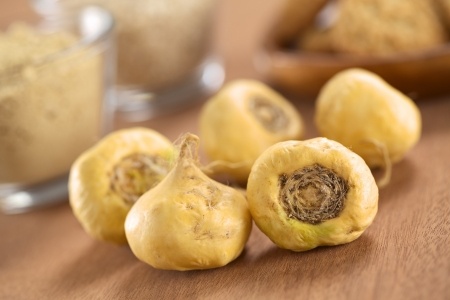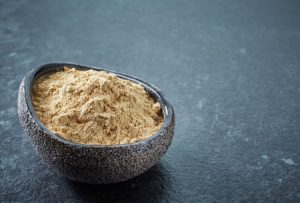

Maca – sounds like a shortened version of macadamia but it really is something quite different.
Maca root has been in use for over 2,000 years. In the late 1990’s it became to find vogue as a herbal medicine in China. Even though it has a long history it is relatively new to the western world and offers those of us who are interested in nutrition some surprising benefits. The Peruvians tend to add the root to dishes given them a slightly earthy, general root vegetable flavour. It is also ground to a powder and added to meals and smoothies. Having claimed that it is not that well known, there are many who do use it regularly – as a sprinkle on coffee or tea to give them a lift in the morning.
Maca root is also fermented to produce a brew known as maca chicha. No idea what it might taste like but I’m sure it is an acquired taste.
It is an ancient crop from Peru and belongs from the same family as radishes, cabbages, rapeseed and cress (the Brassicaceae). The species is known as Lepidium meyeii (Walp). It is still grown in the central highlands of the Peruvian Andes and is known there as ‘Peruvian ginseng’ (Bolin et al., 2000). Indeed there are similarities with ginseng in terms of its clinical and medicinal benefits especially where reducing the effects of tiredness are concerned.
Nutritionally, maca has a valuable treasure chest of minerals and vitamins. One source quotes half a teaspoon which is roughly 2.5 grams containing 10 percent of the recommended vitamin C levels, 15 percent of copper and 10 percent of your daily iron needs. It also contains a reasonable amount of fibre for a start.
It is approved as a novel foodstuff in China (Hao et al., 2014). A number of investigations in both animal and human trials on its health properties have been generated and the applications are numerous:-
- improvement in sexual performance and fertility (Gonzales et al., 2003; Massoma Lembe et al., 2012)
- reducing tiredness and overcoming fatigue (Choi et al., 2012)
- Improving memory (Rubio et al., 2011)
- interactions with hormone regulation (Gonzales et al., 2013)
Nutrition Information Of Maca Powder
| Nutrition | per 15g Serving | per 100g |
| Energy kJ/Kcal | 207/49 | 1380/327 |
| Fat of which saturates |
0.12g 0.03g |
0.8g 0.2g |
| Carbohydrates of which sugars (naturally occuring) |
9.14g 5.7g |
60.9g 38.3g |
| Fibre | 2.7g | 18g |
| Protein | 1.5g | 10g |
| Salt | 0.007g | 0.05g |
The ingredient is suitable for vegetarians, vegans, gluten-free, dairy free and the lactose intolerant. It is not an allergen !
The ingredient can be used in varying amounts but all depends on the user’s nutritional requirements. Adding about 15g to 200ml of cold water is ideal for addition to a homemade smoothie or simply a juice.
Componentry In Maca
Maca contains a number of interesting biochemical including alkaloids (Zhao et al., 2005), polyphenols (Bai et al., 2015), the macamides and maecaenes (Esparza et al., 2015; Zhang et al., 2015) and now the polysaccharides (MPs) (Tang et al., 2017). The macamides are unique to maca which is an interesting proposition to market. Other interesting compounds include imidazole alkaloids such as lepidiline A, B, C & D, macahydantoin, macathiohydantoin, meyeniin, tetrahydro-β – carboline and glucosionolate.
The monosaccharides in Maca have largely been characterized (Zhang et al., 2016) and have been ascribed immunomodulatory benefits. The polysaccharides are less well-known. They have some antioxidant benefit as shown ‘in vitro’ (Zha et al., 2014; Wang et al., 2016). A recent study of the maca polysaccharides suggests their anti-fatigue properties are due to these particular components (Tang et al., 2017).
Memory Improvement With Maca
Peruvian children often take maca to help them perform better at school. The compounds in this herb help to protect neurotransmitters produced in the brain from breaking down. It effectively means the mental faculties are able to function at peak performance. Plenty of research is ongoing into its use for treating dementia.
Boosting Libido
Loss of sexual desire is common in both men and women, especially as we get older. There is evidence from clinical research to suggest taking maca improves libido. One study was a 12-week double blind placebo-controlled, randomized, parallel trial which showed improvement (Gonzalez et al., 2002). Here the men took either 1.5 or 3 grams of maca daily and claimed they had a higher libido when compared to the placebo.
One review assessed four randomized clinical studies which had a total of 131 subjects. Sexual desire improved after supplementation after at least six weeks (Shin et al., 2010).
Helping To Increase Fertility
It is known to improve fertility levels in men in particular or the mode of action is known. It may simply be linked to increased libido however. In 2016, one review highlighted increased semen quality in men who were either fertile or not (Lee et al., 2016). Clearly a lot more research is needed to verify what are probably speculative ideas about the root.
Helping With Wound Healing
Application of the maca root has been shown to speed up recovery from skin lesions.
Reduction Of Prostate Gland
A large prostate is common among older men and can cause issues with urination. Animal studies suggest that red maca can reduce prostate size.
Alleviating Symptoms Of Menopause
The menopause is the situation in a woman’s life when she stops menstruation for ever.
Maca use is associated with alleviating many of the more difficult aspects of the menopause. It has been used for centuries to manage various feminine issues including female hormonal imbalances. There is some evidence suggesting it helps improve the situation (Lee et al., 2011) but again larger and better managed studies need to be conducted to genuinely prove that maca helps resolve menopausal issues.
Overall Thoughts
Well no doubt as more evidence is accrued, maca will continue to intrigue many because of its many supposed properties. The issue is that the ancient views about the use of maca have been distorted to fit particular marketing patterns. One issue is the impact on the Peruvian growers because of the interest in China. There are issues over production and marketing because of the rapid growth of interest in the plant. The sustainability of plant production coupled with adulteration may well adversely affect the use of this product (Beharry and Heinrich, 2018).
Safety and Side Effects
Maca is generally considered safe for consumption based on toxicology studies (Valerio and Gonzales, 2005; Gasco et al., 2007; Gonzales-Arimborgo et al., 2016).
Products
Please read our affiliate disclaimer regarding the purchase of products from our affiliates. Forza offer a branded product called LEAN Active Maca Root in 60 capsules. Every serving contains the equivalent of 10,000mg of pure Maca Root.
References
Bai, N., He, K., Roller, M., Lai, C., Bai, L., Pan, M. (2015) Flavonolignans and other constituents from Lepidium meyenii with activities in anti-inflammation and human cancer cell lines. J. Agr. Food Chem. 63(9) pp. 2458–63
Beharry, S. & Heinrich, M. (2018) Is the hype around the reporudtcive health claims of maca (Lepidium meyenii Walk.) justified ? J. Ethnopharmacol. Jan 30 211 pp. 126-170 https://www.ncbi.nlm.nih.gov/pubmed/28811221
Bolin, Z., Kan, H., Calvin, H.K. (2000) Effect of a lipidic extract from Lepidium meyenii on sexual behavior in and rats. Urology 55(4) pp. 598–602
Choi, E.H., Kang, J.I., Cho, J.Y., Lee, S.H., Kim, T.S., Yeo, I.H., Chun, H.S. (2012) Supplementation of standardized lipid-soluble extract from maca (Lepidium meyenii) increases swimming endurance capacity in rats. J. Funct. Foods 4(2) pp. 568–73
Esparza, E., Hadzich, A., Kofer, W., Mithöfer, A., Cosio, E.G. (2015) Bioactive maca (Lepidium meyenii) alkamides are a result of traditional Andean postharvest drying practices. Phytochemistry 116 pp. 138–48.
Gonzales, G.F., Cordova, A., Vega, K., Chung, A., Villena, A., Gonez, C.( 2003). Effect of Lepidium meyenii (Maca), a root with aphrodisiac and fertility-enhancing properties, on serum reproductive hormone levels in adult healthy men. J. Endocrinol. 176(1) pp. 163–68
Gonzales, G.F., Gasco, M., Lozada-Requena, I. (2013) Role of Maca (Lepidium meyenii) consumption on serum interleukin-6 levels and health status in populations living in the Peruvian Central Andes over 4000 m of altitude. Plant Food Hum. Nutr. 68(4) pp. 347–51
Hao, L., Tian, A., Zhang, L, Liu, N. (2014) Optimization of polyphenols extraction from Maca (Lepidium Meyenii) leaves by response surface methodology. J. Chinese Inst. Food Sci. Technol. 14(12) pp. 86–93
Massoma Lembè D, Gasco M, Gonzales GF. 2012. Fertility and estrogenic activity of Turraeanthus africanus in combination with Lepidium meyenii (Black maca) in female mice. Eur. J. Integr. Med. 4(3):e345–51.
Rubio, J., Yucra, S., Gasco, M., Gonzales, G.F. (2011) Dose-response effect of black maca (Lepidium meyenii) in mice with memory impairment induced by ethanol. Toxicol. Mech. Method 21(8) pp. 628–34
Tang, W., Jin, L., Xie, L., Huang, J., Wang, N., Chu, B., Dai, X., Liu, Y., Wang, R. and Zhang, Y. (2017), Structural Characterization and Antifatigue Effect In Vivo of Maca (Lepidium meyenii Walp) Polysaccharide. Journal of Food Science, 82 pp. 757–764. doi:10.1111/1750-3841.13619
Zhang, J., Wang, H., Zhao, Y., Zuo, Z., Wang, Y., Jin, H. (2015) Comparison of mineral element content in a functional food Maca (Lepidium meyenii Walp.) from Asia and South America. J. Anal. Methods Chem. 2015 pp. 1–4
Zhang, M., Wang, G., Lai, F., Wu, H. (2016) Structural Characterization and immunomodulatory activity of a novel polysaccharide from Lepidium meyenii. J. Agr. Food Chem. 64(9) pp. 1921–31
Zhao, J., Muhammad, I., Dunbar, D.C., Mustafa, J., Khan, I.A. (2005) New Alkamides from Maca (Lepidium meyenii ). J. Agr. Food Chem. 53(3) pp. 690–93.

Leave a Reply